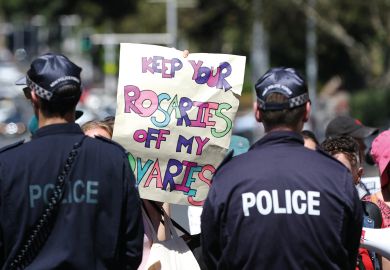The global importance of the Antarctic continent is now well understood. It has far-reaching impacts on climate, the atmosphere and the oceans. Antarctica is the storehouse for 90 per cent of the world's freshwater resources and there are significant marine and mineral resources. Its role in scientific research is fundamental: scientists from at least 43 countries are conducting investigations there. Above all, the Antarctic is the last great wilderness and the most pristine continent on our planet. Not suprisingly, Antarctica has generated a plentiful literature. Christopher Joyner, who is professor of international law at Georgetown University, has contributed one of the most authoritative and valuable studies to date in Governing the Frozen Commons . His prime concern is how the continent can be managed and protected in the face of ever-increasing activity.
The book begins with the obligatory outline of the physical geography, resources, flora and fauna, climate and so on, and outlines the history of national territorial claims in Antarctica. Although minerals feature prominently in debates about the Antarctic regime there is no mention of mineral resources in an otherwise excellent review. There are three background maps including one showing the location of 44 scientific stations in Antarctica. Joyner argues that Antarctica is as much part of the "global commons" as the deep seabed or the upper atmosphere, being physically and legally beyond the limits of national jurisdiction. He also argues that national territorial claims in Antarctica are invalid, because no state has yet effected "true and effective occupation demonstrated through permanent settlement", without which claims to territory are not valid in international law. The 1959 Antarctic treaty is the bedrock of the regime for the governance of Antarctica. Article IV freezes the seven sovereignty claims on the continent, thus giving treaty states the confidence to work together over other vital articles. Joyner gives an admirable account of the complexities of the Antarctic treaty system (ATS) as a whole.
The ATS comprises the 1959 treaty, various recommendations from the annual meetings of the Antarctic Treaty Consultative Parties (ATCP), the 1972 seals convention, the 1980 Convention for Conservation of Antarctic Marine Living Resources (CCAMLR) and the crucial 1991 protocol to the Antarctic treaty on environmental protection (the Madrid protocol). Besides these agreements, a number of important external instruments, such as the 1982 United Nations convention on the law of the sea, also impinge on Antarctica. Taken together, these treaties constitute the governing regime of Antarctica. Joyner concludes that the system has worked suprisingly well: "The record of compliance ... may be better than for any other international agreement this century. For nearly four decades the Antarctic treaty has functioned without a single serious violation of its norms, rules, principles or procedures by its member governments."
Joyner's broad commendation of the ATS is balanced throughout the book by evidence of the weaknesses and failures of the ATS, such as its inability to deal with illegal fishing in areas ostensibly protected by CCAMLR and its powerlessness in respect of the activity of non-treaty parties in Antarctica. One of the finest chapters in the book traces the objections of a number of developing countries to the ATS during the 1980s. They wished to see Antarctica recognised as part of the common heritage of mankind, to be managed for the benefit of the world as a whole. They deplored the government of an entire continent by treaty arrangements between members of a self-selected club. With the question of mineral exploitation shelved by the Madrid protocol for at least 50 years, the common-heritage debate has died down, but it could revive if the ATS were to seem to fail its duty to the continent.
The author assesses the effectiveness of the ATS in achieving resource conservation and environmental protection. As to conservation efforts, the picture is patchy. Inevitably much attention is given to CCAMLR, which is the largest conservation zone in the world and the first fisheries agreement to monitor the effect of commercial activity on an entire ecosystem. Monitoring began in 1985 with the ecosystem monitoring programme, which has produced valuable scientific data, but according to Joyner, policy considerations in Antarctica are still handicapped by gaps in information. Overall, however, he regards CCAMLR as a successful conservation instrument.
Much the same is true of environmental protection. The 1991 Madrid protocol was created in the aftermath of the diplomatic wreckage left by disagreements over the need for a minerals convention in 1988. The protocol represents a profound change of direction since it implies "a legal commitment to protect and preserve the Antarctic environment, lending the region a status akin to a world park". The Madrid protocol is one of the most comprehensive environmental agreements ever concluded, but it may be severely tested in the coming decades as scientific activity intensifies in the Antarctic and as tourist numbers increase far beyond current levels of just over 10,000 per annum. In essence, the message of Governing the Frozen Commons is that the measures and institutional frameworks to ensure peaceful management and effective environmental protection in Antarctica are now broadly in place. Much will now depend on the commitment of member states to the ATS.
This book, which is thoroughly researched and clearly written, makes a substantial contribution to our understanding of what is good, and what is in need of attention, in the governance of Antarctica. It should become compulsory reading for all Antarctic specialists, especially policy-makers. Students of international law, geography and political science will also find it a thoroughly readable and illuminating study.
G. H. Blake is director, international boundaries research unit, University of Durham.
Governing the Frozen Commons: The Antarctic Regime and Environmental Protection
Author - Christopher C. Joyner
ISBN - 1 57003 239 4 and 4 2
Publisher - University of South Carolina Press
Price - £39.95 and £19.95
Pages - 362
Register to continue
Why register?
- Registration is free and only takes a moment
- Once registered, you can read 3 articles a month
- Sign up for our newsletter
Subscribe
Or subscribe for unlimited access to:
- Unlimited access to news, views, insights & reviews
- Digital editions
- Digital access to THE’s university and college rankings analysis
Already registered or a current subscriber?



